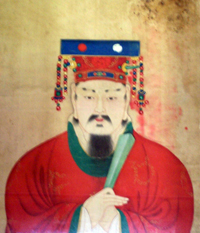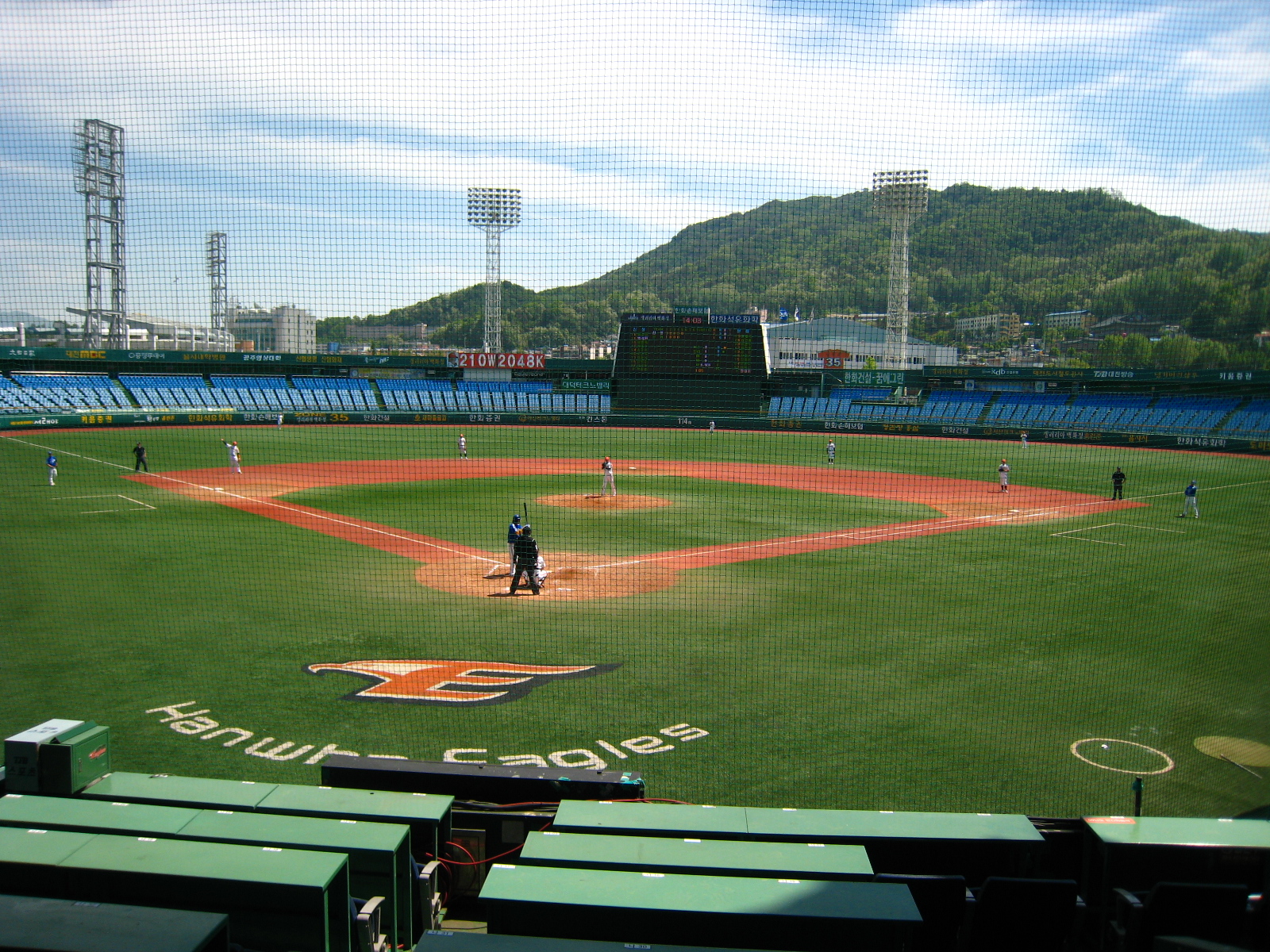|
2016 Korea National League
The 2016 Korea National League, also known as the Incheon International Airport National League 2016 due to the sponsorship of Incheon International Airport, was the 14th season of the Korea National League, the third tier of South Korea's football league system. Each of the ten clubs played three times against all other clubs in the regular season, and the top four clubs of the regular season qualified for post-season playoffs. Hyundai Mipo Dockyard won their seventh league title after winning the two-legged final, but they dissolved their football club after the end of the season due to financial difficulties. Yongin City also dissolved their football club after being disappointed with poor results of the club. Gangneung City goalkeeper Park Chung-hyo became the first player to win the MVP award without the league title. Teams Regular season League table Positions by matchday Championship playoffs See also *2016 in South Korean football *2016 Korea National L ... [...More Info...] [...Related Items...] OR: [Wikipedia] [Google] [Baidu] |
Korea National League
The Korea National League was a South Korean semi-professional football league held annually from 2003 to 2019. It was considered the second-highest division of the South Korean football league system before the K League 2 was launched in 2013, and the third-highest division since then. History The Korea National League was officially founded in the name of ''K2 League'' in 2003 to execute a plan to professionalize the Korean National Semi-Professional Football League. The participating clubs of the National League had to have their hometowns unlike in the Semi-professional League era. In 2006, the K2 League was rebranded as the Korea National League, and its champions were decided to promote to the K League. However, Goyang KB Kookmin Bank and Hyundai Mipo Dockyard, the champions of the 2006 and 2007 season respectively, judged that they couldn't derive benefit from their professionalization, and rejected their promotion. The Korea Football Association and the K League Feder ... [...More Info...] [...Related Items...] OR: [Wikipedia] [Google] [Baidu] |
Busan
Busan (), officially known as is South Korea's most populous city after Seoul, with a population of over 3.4 million inhabitants. Formerly romanized as Pusan, it is the economic, cultural and educational center of southeastern South Korea, with its port being Korea's busiest and the sixth-busiest in the world. The surrounding "Southeastern Maritime Industrial Region" (including Ulsan, South Gyeongsang, Daegu, and some of North Gyeongsang and South Jeolla) is South Korea's largest industrial area. The large volumes of port traffic and urban population in excess of 1 million make Busan a Large-Port metropolis using the Southampton System of Port-City classification . Busan is divided into 15 major administrative districts and a single county, together housing a population of approximately 3.6 million. The full metropolitan area, the Southeastern Maritime Industrial Region, has a population of approximately 8 million. The most densely built-up areas of the city are situated in ... [...More Info...] [...Related Items...] OR: [Wikipedia] [Google] [Baidu] |
Gyeongju Civic Stadium
Gyeongju Civic Stadium ( ko, 경주시민운동장) is a multi-use stadium in Gyeongju, South Korea. It is used mostly for football Football is a family of team sports that involve, to varying degrees, kicking a ball to score a goal. Unqualified, the word ''football'' normally means the form of football that is the most popular where the word is used. Sports commonly c ... matches. External links Football venues in South Korea Sports venues completed in 1979 1979 establishments in South Korea Athletics (track and field) venues in South Korea {{SouthKorea-sports-venue-stub ... [...More Info...] [...Related Items...] OR: [Wikipedia] [Google] [Baidu] |
Gyeongju
Gyeongju ( ko, 경주, ), historically known as ''Seorabeol'' ( ko, 서라벌, ), is a coastal city in the far southeastern corner of North Gyeongsang Province in South Korea. It is the second largest city by area in the province after Andong, covering with a population of 264,091 people (as of December 2012.) Gyeongju is southeast of Seoul, and east of Daegu. The city borders Cheongdo and Yeongcheon to the west, Ulsan to the south and Pohang to the north, while to the east lies the coast of the Sea of Japan. Numerous low mountains—outliers of the Taebaek range—are scattered around the city. Gyeongju was the capital of the ancient kingdom of Silla (57 BC – 935 AD), which ruled about two-thirds of the Korean Peninsula at its height between the 7th and 9th centuries, for close to one thousand years. Later Silla was a prosperous and wealthy country, and its metropolitan capital of Gyeongju was the fourth largest city in the world. A vast number of archaeological sites an ... [...More Info...] [...Related Items...] OR: [Wikipedia] [Google] [Baidu] |
Gimhae Stadium
Gimhae Stadium is a multi-purpose stadium in Gimhae Gimhae () is a city in South Gyeongsang Province, South Korea. It is the seat of the large Gimhae Kim clan, one of the largest Kim clans in Korea. The Gimhae Kims claim descent from the ancient royal house of Geumgwan Gaya, which was based in Gim ..., South Korea. It is currently used mostly for football (soccer), football matches. The stadium has a capacity of 25,000 people and was opened in 2005. External links Gimhae Sports Facilities Management Center Football venues in South Korea Multi-purpose stadiums in South Korea Sports venues in South Gyeongsang Province {{SouthKorea-sports-venue-stub ... [...More Info...] [...Related Items...] OR: [Wikipedia] [Google] [Baidu] |
Gimhae
Gimhae () is a city in South Gyeongsang Province, South Korea. It is the seat of the large Gimhae Kim clan, one of the largest Kim clans in Korea. The Gimhae Kims claim descent from the ancient royal house of Geumgwan Gaya, which was based in Gimhae. Gimhae is situated near the Nakdong River. The city has a K3 League soccer club called Gimhae FC. The largest foreign sports club in Gimhae is the Gimhae Semi-Athletic Club (G-SAC) located in Nae-dong. Gimhae is also the birthplace of the late Roh Moo-hyun, former president of South Korea. Administrative divisions * Jinyeong-eup (13 ''ri'') * Daedong-myeon (10 ''ri'') * Hallim-myeon (12 ''ri'') * Jillye-myeon (10 ''ri'') * Juchon-myeon (8 ''ri'') * Saengnim-myeon (8 ''ri'') * Sangdong-myeon (6 ''ri'') * Bukbu-dong (3 legal ''dong'') * Buram-dong (2 legal ''dong'') * Buwon-dong * Chilsanseobu-dong (7 legal ''dong'') * Dongsang-dong *Hoehyeon-dong (2 legal ''dong'') * Hwalcheon-dong (2 legal ''dong'') * Jangyu-dong (3 legal ''dong'' ... [...More Info...] [...Related Items...] OR: [Wikipedia] [Google] [Baidu] |
Gangneung Stadium
The Gangneung Stadium is a multi-purpose stadium in Gangneung, South Korea. It is currently used mostly for football (American English: soccer) matches. The stadium has a capacity of 22,333 spectators and was opened in 1984. It is the home ground of Gangneung City FC and Gangwon FC (since 2009). It is located within the Gangneung Olympic Park The Gangneung Olympic Park is a sports complex area in Gyo-dong, Gangneung, South Korea, which contains four of the 2018 Olympic Games venues and served as the Olympic Park. It includes the following venues: * Gangneung Hockey Centre – Ice H ..., one of the main sites of the 2018 Winter Olympics. External links Gangneung Sports Facilities Management Center World Stadiums Football venues in South Korea Gangwon FC Ulsan Hyundai FC Multi-purpose stadiums in South Korea Sports venues in Gangneung Sports venues completed in 1984 K League 2 stadiums {{SouthKorea-sports-venue-stub ... [...More Info...] [...Related Items...] OR: [Wikipedia] [Google] [Baidu] |
Gangneung
Gangneung () is a municipal city in the province of Gangwon-do, on the east coast of South Korea. It has a population of 213,658 (as of 2017).Gangneung City (2003)Population & Households. Retrieved January 14, 2006. Gangneung is the economic centre of the Yeongdong region of Gangwon-do. Gangneung has many tourist attractions, such as Jeongdongjin, a very popular area for watching the sun rise, and Gyeongpo Beach. There is an ROKAF airbase south of downtown Gangneung that formerly doubled as a civil airport. The city hosted all the ice events for the 2018 Winter Olympics. History Gangneung was the home of the Yemaek people in ancient times and became the land of Wiman Joseon in 129 BC. In 128 BC, Nam Ryeo, the army officer of Yaekam, punished Wujang of Wiman Korea and became the territory of the Han dynasty. In the 14th year of Goguryeo Muchheon (313), it entered Goguryeo territory. In 639, Silla occupied this place and ruled it as a 'Sogyeong' (). In 658, King Moo-yeo ... [...More Info...] [...Related Items...] OR: [Wikipedia] [Google] [Baidu] |
Daejeon Hanbat Stadium
Daejeon Hanbat Sports Complex ( ko, 대전한밭종합운동장) is a sports complex, comprising a multi-purpose stadium (including athletic facilities and a soccer pitch), a ballpark, Basketball courts, tennis courts and various other sports facilities in Daejeon, South Korea. Facilities Daejeon Hanbat Stadium The Daejeon stadium (main stadium) has a capacity of 20,618 and opened in 1964. It was used by Daejeon Citizens before Daejeon World Cup Stadium opened and the team relocated in 2001. It hosted several football preliminaries during the 1988 Summer Olympics in Seoul. Daejeon Baseball Stadium Daejeon Hanbat Baseball Stadium was opened in 1965, and undergone a significant renovation and expansion in 2012. It now has a capacity of 13,500, and serves as home for Hanwha Eagles of Korea Professional Baseball League. Chungmu Gymnasium Chungmu Gymnasium is an indoor sports facility that can be used as basketball, or volleyball stadium. It currently serves as home for ... [...More Info...] [...Related Items...] OR: [Wikipedia] [Google] [Baidu] |
Daejeon
Daejeon () is South Korea's fifth-largest metropolis, with a population of 1.5 million as of 2019. Located in the central-west region of South Korea alongside forested hills and the Geum River, the city is known both for its technology and research institutions, and for celebrating its natural environment, with most mountains, hot springs, and rivers freely open for public use. Daejeon serves as a hub of transportation for major rail and road routes, and is approximately 50 minutes from the capital, Seoul, by KTX or SRT high speed rail. Daejeon (along with Seoul, Gwacheon and Sejong City) are collectively South Korea's administration hubs. The city is home to 23 universities and colleges, including Korea Advanced Institute of Science and Technology (KAIST) and Chungnam National University, as well as government research institutes, and research and development centers for global companies such as Samsung, LG, mostly located in the city's Daedeok Science Town. Occupied b ... [...More Info...] [...Related Items...] OR: [Wikipedia] [Google] [Baidu] |
Cheonan Stadium
Cheonan Stadium ( ko, 천안종합운동장) is a multi-purpose stadium in Cheonan, South Korea. Built in 2001, it is currently used mostly for football matches and can accommodate 26,000 spectators. On 15 October 2013, the South Korea national football team used the stadium for the first time in the friendly match against Mali, which ended in a 3–1 victory for South Korea. The stadium also hosted nine matches at the 2017 FIFA U-20 World Cup The 2017 FIFA U-20 World Cup was the 21st edition of the FIFA U-20 World Cup, the biennial international men's youth football championship contested by the under-20 national teams of the member associations of FIFA, since its inception in 1977 as .... References External linksOfficial websiteWorld Stadiums Football venues in South Korea Sport in South Chungcheong Province Multi-purpose stadiums in South Korea Athletics (track and field) venues in South Korea Buildings and structures in Cheonan Sports venues completed in 2001 ... [...More Info...] [...Related Items...] OR: [Wikipedia] [Google] [Baidu] |




